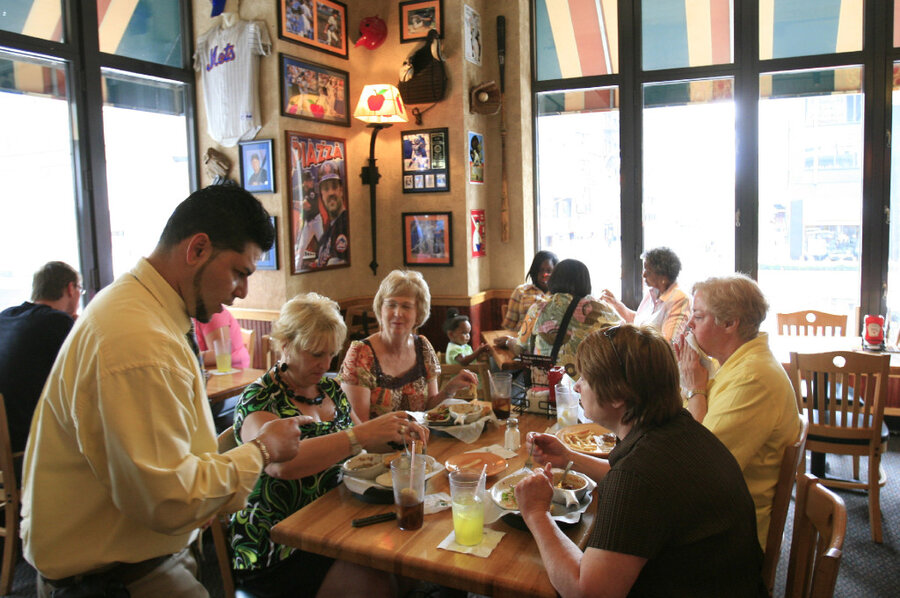Why are restaurants losing sit-down customers?
Loading...
Traditional sit-down chain restaurants are seeing fewer sales as customers value convenience and affordability over the tried and true.
The food industry is still growing, but in different sectors than before. Mid-range, sit-down restaurants like Chili's are struggling, while new food trends take hold, especially among young people, who often want their food quickly and on-the-go, according to industry expert Darren Tristano, president of Technomic. They're "looking for convenience, quality, portability and healthfulness," Mr. Tristano told the Associated Press.
Uncertainty is par for the course for new, independent restaurants, but now large chains are showing signs of stress: the chief executive officer of Ruby Tuesday’s has resigned after another quarter of dismal sales, and Darden Restaurants sold off Red Lobster in 2014. Last year, Panera Bread, where customers pick up their order at the counter, overtook Applebee's, the last sit-down chain in the top 10 restaurant companies by sales.
But as Americans' eating and shopping habits shift, new food providers are moving into the market, from "fast casual" to food trucks – or expanding options for at-home eating, too, including online grocery shopping, whether basic or meal-in-a-box.
To traditional restaurant-goers, "fast casual" restaurants such as Panera might seem a step below a sit-down restaurant where you can relax and wait for food at the table. But criteria may be different for Millennials, who make up 51 percent of fast casual customers, according to a report from Morgan Stanley.
"With places like Panera and Chipotle ... it is fast food, disguised as not fast food. We have all got the message 'Don't eat fast food, it is unhealthy,' and we go to a place like Panera or Chipotle because they don't have a drive-through and it is not all deep fried," says Stephanie Medley-Rath, an associate professor of sociology at Indiana University Kokomo, who has written about food sociology, in an interview with The Christian Science Monitor. "If you go to any of these places their costs are pretty comparable. I am still going to be spending $8-10."
Along with higher-end fast food chains, food trucks have become a popular choice among younger eaters.
The food truck movement, which started in California in 2008 and then exploded in cities across the United State, has the same appeal, plus a caravan of food trucks presents a more diverse array of food than one single restaurant can easily offer. With just a few dishes each and no permanent location, food trucks let customers and chefs experiment with food that is both convenient and generally cheap.
"We like to try different things [on the menu] and have fun, and the food truck allowed this," Sienam Lulla, who owns a Chinese food truck and two restaurants in Boston, told the Monitor in 2013. She added that corporate restaurants often get locked into specific menus with little flexibility.
Food trucks that are by nature on-the-go make it easy for casual foodies to experiment with new foods without investing a great deal of time or money.
The popularity of shopping online for food – not just take-out but groceries – has also spiked. However, in the case of online grocery shopping, the goal is often not about bargain-hunting but finding elusive ingredients.
According to a Harris poll, 31 percent of US consumers purchase food online, about half to find foods not available in a regular grocery store. The success of online food suppliers like Thrive Market points to the size of this booming market: the company ships $200,000 in products each day.
For those who don’t want to choose their own food, dozens of mail order food subscriptions – like Blue Apron, which delivers all the ingredients to make an entire meal to a cook's door – offer every type of food pre-curated for customers.
The focus on gourmet food when shopping online suggests perhaps people would rather have quality food at home, and see eating out as more of a matter of on-the-go convenience than a luxury.
"There is a trend of making things from scratch that have a pre-made counter part," Dr. Medley-Rath tells the Monitor, referring to services like Blue Apron that do most of the leg work for you. "The trend is certainly fueled by things like Pinterest and the web in general." But it may not be a lasting one, she adds: "I am not sure how long monthly subscriptions will last; it may be a fad."
This report includes material from the Associated Press.








